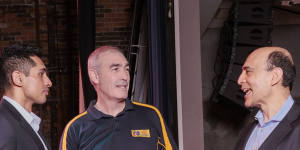But it was watching news reports of his own sudden cardiac arrest in January 2020 – and how an off-duty nurse had — that shocked him into action.

Greg Page with Pramesh and Joshua Kovoor on the stage at Castle Hill RSL where the former Wiggle suffered a cardiac arrest in January 2020.Brook Mitchell
“When you wake up in hospital,and you see your story on the news,you kind of feel like you’ve got to do something about it,” he said. “We still have only a 10 per cent survival rate ... I just cannot believe that there’s not more being done.”
The revelation – that he was one of only 10 per cent of people to survive a sudden cardiac arrest – set Page on a mission to improve the situation for the other 90 per cent.
The 51-year-old is pushing the newly elected NSW Labor government to follow the lead of South Australia,which in November became the first state or territory in the country to pass laws making defibrillators mandatory in all public buildings including schools,libraries and sporting facilities.
“There’s no reason why other states and territories cannot follow suit,” he said. “This technology has been around for at least 30 years. Now is the time to make it mainstream.”

Greg Page in his days as the Yellow Wiggle.Dallas Kilponen
The episode has given Page a renewed purpose and a close relationship with associate professor Pramesh Kovoor,the cardiac surgeon on call at Westmead Hospital when Page in January 2020.
As the director of cardiac services,Kovoor had helped move the department towards a system where cardiac patients are triaged in the ambulance,rather than the emergency ward,enabling the on-call cardiac team to have the operating theatre ready for surgery as soon as the patient reaches hospital.
“We got sent the ECG results which showed that clearly Greg was having a heart attack,” he said. “By the time Greg got there,we were already there ... and within a few minutes,we were able to restore flow,and there was essentially no damage to the heart muscle.”
Ever since,Kovoor has been working with Page’s charity,Heart of the Nation,to boost public awareness and access to defibrillators. This includes making signage for automated external defibrillators (AEDs) more visible and universal across the country.
‘The shorter the delay,the better. It’s really a no-brainer.’
Associate Professor Pramesh Kavoor,on why access to defibrillators needs to improve
Around 20,000 people suffer sudden cardiac arrest in Australia each year,the Heart Foundation. The survival rate has remained constant around 10 per cent in Australia,but research from Japan,an early adopter of public-access defibrillators,found that increased to 62 per cent for patients who were shocked within five minutes of collapse.
“The shorter the delay,the better,” said Kovoor. “It’s really a no-brainer.”
AEDs only deliver a shock if it can detect a heart rhythm. In 2020,only 26 per cent of out-of-hospital cardiac arrests attended by NSW Ambulance had a heart rhythm responsive to defibrillation.
South Australia’s Labor government will spend $9.1 million over three years to install defibrillators in all government buildings and vehicles including public buses,trains and trams,and emergency vehicles.
Although the cost would be higher in NSW,with a population four times the size of South Australia,Page said the economic benefit would far outweigh the initial costs.
Kovoor’s son Joshua,a medical trainee at Queen Elizabeth Hospital in Adelaide,said the bipartisan bill had been positively received in South Australia,and the medical community was optimistic it would have flow on effects to other issues affecting the hospital system such as ambulance ramping.
“If you have sicker patients in hospital for longer,that takes up the bed and space for others,” he said.
A spokesperson said the NSW government would “carefully monitor the roll-out of the SA legislation and glean any lessons that may be learned”.
Last year the government spent $2.5 million on the GoodSAM smartphone app,which alerts trained responders to nearby cardiac arrests,and provided up to $9000 in grants for sporting clubs to purchase AEDs.
The Morning Edition newsletter is our guide to the day’s most important and interesting stories,analysis and insights..